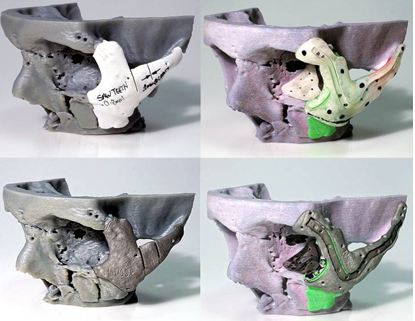Man Receives 3D Printed Facial Reconstruction

Doctors modeled the 3D printed guides and implants for Powers’ facial reconstructive surgery prior to the operation. Courtesy of Morriston Hospital.
Latest News
March 12, 2014
Additive manufacturing (AM) is improving the standard of living for people around the world. Quite apart from its contributions to science and industry, 3D printing is capable of offering solutions to complex medical problems. One area of particular note is the AM of prosthetics and bone reconstruction, with multiple surgeries taking advantage of the technology.
One of the latest recipients of 3D printed reconstructive elements is Stephen Powers, a 31 year-old man from Cardiff, Wales. Powers was involved in an automobile accident in 2012 while riding his motorcycle. Though wearing a helmet, he suffered a number of serious injuries, including damage to his face and left eye.

All told, Powers broke both arms, his right leg, both cheek bones, both eye sockets and his upper jaw, along with a fractured skull. Emergency reconstructive efforts immediately following the accident were able to repair the worst of the injuries, but left Powers with cosmetic damage to his face.
“We were able to do a pretty good job with all his facial injuries, with the exception of his left cheek and eye socket,” said maxillofacial surgeon Adrian Sugar. “We fixed his facial fractures pretty well, but he had damaged his left eye and the ophthalmologists did not want us to do anything that might damage his sight further.
“That was a good move because his eyesight has mostly recovered. But as a result we did not get his left cheekbone in the right place and we did not even try to reconstruct the very thin bones around his eye socket. So the result was that his cheekbone was too far out and his eye was sunk in and dropped.”
In 2013, doctors began planning for a more thorough reconstructive effort using AM. The work was a joint partnership between Morriston Hospital’s Maxillofacial Unit and the National Centre for Product Design and Development Research (PDR) at Cardiff Metropolitan University.
The medical team used 3D scans of Powers’ face to construct 3D printed guides that would assist surgeons while cutting and repositioning his bones. AM was further used to build medical-grade titanium plates that would hold the reconstruction together. Leveraging the power of AM allowed the surgeons to be far more precise in their work than would previously have been possible.
“Being able to do that and to put them (the bones) back in the right position was a complex three dimensional exercise,” said Sugar. “It made sense to plan it in three dimensions and that is why 3D printing came in — and successive 3D printing, as at every different stage we had a model. We did two types of model planning — virtual model planning on a computer screen and physical model planning. Without this advanced technology, it’s freehand. You have to guess where everything goes. The technology allows us to be far more precise and get a better result for the patient.”
Powers graded the results of his surgery a nine out of 10, and has said he now feels comfortable leaving the house without wearing the concealing glasses and hat he previously hid behind. While his left eye is still slightly higher than the right, doctors are hopeful that as his face adjusts to the implants the eye will drop into a more natural position.
Below you’ll find a video about another reconstructive effort involving 3D printing.
)
Subscribe to our FREE magazine, FREE email newsletters or both!
Latest News
About the Author
John NewmanJohn Newman is a Digital Engineering contributor who focuses on 3D printing. Contact him via [email protected] and read his posts on Rapid Ready Technology.
Follow DE





